Chip Jacobs's Blog, page 3
June 14, 2021
“The Accidental True Crime Writer” – my Los Angeles Review of Books essay
WHEN MY CITY EDITOR yelled out that she needed someone to help cover a shooting at the County General Hospital in East Los Angeles, I sunk low behind my computer, trying to be invisible. As a young metro reporter focusing on transportation back in 1993, I had barely typed a word about violent crime.
Forty minutes later, I lingered near one of the hospital’s side entrances, unable to spot any fellow journalists milling around. So, I popped open the door, figuring they might be inside. That’s when a tubby police officer whipped around the corner, telling me in an angry whisper that the gunman who’d already shot three doctors — one with a .38-caliber slug to the head — was holding two people hostage just around the bend. “Get down and go!” he said, his hand gripping a revolver.
I left, lucky only to have been chastised, and discovered the media scrum in an adjacent parking lot. It was now your basic hurry-up-and-wait while authorities tried to end the standoff with the gunman, a disgruntled patient who lived on Skid Row. They hauled him off in a squad car after several hours, and as I angled for a view of his face, an overly aggressive TV cameraman whacked me in the back of the head with his lens. But I still noticed the suspect resembled Richard Ramirez, the “Night Stalker” serial killer who had terrorized Los Angeles the previous decade.
By nightfall, with our story for the San Gabriel Valley Tribune in editing, I needed to decompress. I ripped off my nicotine patch and bought the last pack of cigarettes I’d ever smoke.
The O. J. Simpson murders would be the next crime story I’d write about, if tangentially, for the Los Angeles Times and its rival, the Los Angeles Daily News. Full-time crime reporters, as I learned, were the characters in the newsroom, often cynical, swashbuckling, and as brash as the cops with whom they interacted. I didn’t run in that herd.
It wasn’t until one day in 1998, strolling along Hollywood Boulevard, that I got stopped on the sidewalk by a guy named Jerry Schneiderman who had been both a source for stories and a bit of a fabulist.
“Did you know,” he said, “that I once had a double murderer chasing me?”
He claimed the ordeal ruined the “old” him, gutting his first marriage and leaving him forever mistrustful of strangers.
Yeah, right, I said, figuring he was either pulling my chain, as he was apt to do, or exaggerating something unverifiable.
Never was I more wrong.
Schneiderman had been a nerdy 27-year-old space-planning prodigy when his partner, a suave, charismatic fellow 12 years his senior, persuaded him into something of a real estate get-rich-quick scheme: adding construction services to their otherwise white-collar business sketching interior blueprints for Los Angeles companies big and small. In need of an experienced foreman — and a California contractor’s license — they hired a quiet, windburned applicant, sight unseen. What Schneiderman didn’t know was that both his colleagues bore secrets, one more diabolical than the other. From the ashes of financial misconduct and palace intrigue soon emerged a sequence of events out of an Elmore Leonard novel.
Then again, life in 1979 Los Angeles made for plenty of deadbolted doors and just as much paranoia. Murder rates were spiking. “White flight” was growing, as were gated communities and racial tensions between people of color and the increasingly militarized LAPD. Worse, overlapping serial killers (like “The Hillside Strangler” and “The Freeway Killer”) seemed to prowl at their leisure.
Beyond the criminality, Southern California exuded this seething aura, just like the rest of a demoralized post-Vietnam, post-Watergate United States, except amid palm trees and famous boulevards. The anchor’s rant in Paddy Chayefsky’s brilliant Network, where he encouraged viewers to scream that they were “mad as hell,” felt less Hollywood drama than modern documentary. There was a noir quality to our existence that rendered even our beloved La Brea Tar Pits a shadowy expanse you didn’t want to hang around at night. A 17-year-old at the time, what I remember now are the gloomy skies and sullen adults.
Years later, I realized that Schneiderman only had a keyhole-wide understanding of the darkness that had swirled around him. For instance, he had little understanding that his partner’s execution with a powerful World War II–era rifle represented the opening salvo in a boutique murder-for-profit corporation. The ringleader of it was Howard Garrett, their vulture-faced foreman who’d decided to toss caution to the wind by cashing in on other people’s demises. In a tense meeting where Garrett blackmailed Schneiderman, threatening him and his family with their own murder contracts, Garrett warned Schneiderman that he had killed before “and gotten away with it.” He wasn’t lying.
The web of would-be assassins that ensnared Schneiderman included a bantam-sized gunman with a deadeye aim, a transgender thief, and a bisexual white supremacist crook with a grain of conscience.
But I never could’ve unearthed a drop of this 20-year-old saga without my journalism background. As such, I spent hours in the Hall of Records’s dungeon-esque basement in downtown Los Angeles, examining court filings, even though many were missing or stolen. I interviewed dozens of people swept up in Garrett’s months-long reign of terror, among them former LAPD homicide detectives who, like Schneiderman, couldn’t forget Garrett. Eventually, I connected with the lead prosecutor, who offered public documents that confirmed the outlines of this weirder-than-fiction tale.
One salacious document showed that between the time when Schneiderman’s business partner was murdered and Garrett was dramatically arrested he worked on a freelance construction job at the offices of the California Association of Realtors, a trade group promoting integrity in the real estate business.
All of this digging kept me at a comfortable distance from the actual villains involved. I still craved to learn more, and with Garrett long dead, there was only one person who knew the truth about him: the triggerman who’d fired the fateful bullet into the head of Schneiderman’s feather-haired partner, Richard Kasparov.
Johnny Williams was many things: a bushy-haired man who had already admitted to killing multiple people before this, an industrious criminal alchemist, and the victim of a traumatic brain injury from tumbling out of a moving car. That pivotal event had demented him from a kid with a soaring IQ into a sociopath.
To hear him out, I typed up a letter requesting an interview, and then, probably a dozen times, stuck it in my mailbox only to retract it moments later. Williams had testified under oath, to a stupefied courtroom, that killing to him was no big deal. Years later, the parole board at Corcoran State Prison in Central California repeatedly denied his release, deeming him an ongoing threat to society.
What if my nosy questions about what landed him behind bars incensed him and he was subsequently freed? Even the internet of the early aughts made it simple to locate someone’s address. Would he pop up outside my window with a big gun, just as he had with Schneiderman’s partner, for one last slaughter? What about my family? Were Williams’s sinister memories worth it?
That one-page letter collected dust in my file cabinet for two years as I hemmed and hawed, weighing the risk, when I heard that Williams died behind bars.
Then I wrote The Darkest Glare, a nonfiction account that tried to stitch all the craziness together into a single book. I hope I did it justice without Williams.
I was confident I could handle not only the Kafkaesque twists of Schneiderman’s ordeal but also the prologue of it — the PTSD, the legal and emotional dominoes that cascaded afterward, the questions about hidden identities behind the smiles of Los Angeles contractors. And that’s all because a distracted city editor shooed me out the door to cover that hospital shooting. The best story is the one you never set out to write.
The post “The Accidental True Crime Writer” – my Los Angeles Review of Books essay appeared first on Chip Jacobs .
May 13, 2021
Meet Chip Jacobs: Author, journalist, dog-enthusiast, spiritual optimist

We had the good fortune of connecting with Chip Jacobs and we’ve shared our conversation below.
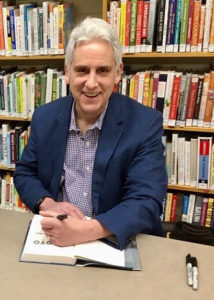 Hi Chip, why did you decide to pursue a creative path?
Hi Chip, why did you decide to pursue a creative path?
In fall 1982, at parents’ night at my college fraternity, I dropped a bomb on my father, telling him that I was switching my major from business administration to journalism. He’d been a child of the Great Depression, having me in his mid-forties, and ever since disdained newspaper reporters as sort of bottom-scrapers who recorded the day’s big events rather than contributing to society writ large. The argument that erupted between us that evening felt like the climax of a John Hughes coming-of-age movie. Suddenly, a 100+ people listening to a speaker up front swiveled their heads to the back of the meeting hall to hear me scream that this was MY damn life, not his to plot out; that my heart would never be in a soulless corporate job, let alone the slow-suicide of working in family real estate business, however much it’d paid my way. We were a couple of distant planets afterwards, him furious, me terrified about the ramifications of my ill-timed declaration of independence. Somehow, we remained on speaking terms.
By 1990, after flirting with the idea of a career as CIA analyst (you know, to save the world from nuclear apocalypse), I secured my first reporting job at the Los Angeles Business Journal. Never was I happier. It wed my natural, admittedly annoying curiosity with a genuine love of writing, filling me with pride and a hunger to improve every day. Seven years, and a bunch of newspaper posts later, I took another plunge you could either term courageous or self-sabotaging. On a decided roll, with the Los Angeles Times interested in hiring me after a string of front-page exposes, I up and quit its fierce rival, the Los Angeles Daily News, to pen my first book, Strange As It Seems. My editor and others begged me not to, that I was making a terrible mistake, but hazy voices seemed to be calling me. My mother’s side of the family, I knew by then, was chalked with creatives. There was that famous European dancer, a Broadway star, Hollywood directors and musicians; heck, author Irving Stone was a distant cousin.
Still, in leaving a job I adored for this more solitary pursuit, I frequently second guessed my decision to walk away from the never-dull newsroom. When a 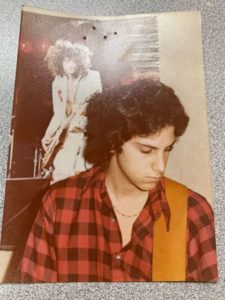 preliminary book deal with St. Martin’s Press fizzled, it seemed as though I’d magically converted that potential folks told me I had into smoking ruin. My second book about the “Great” L.A. smog crisis garnered critical acclaim, though releasing it at the onset of the “Great Recession” was a recipe for commercial frustration. I plowed ahead after Smogtown anyway, reminding myself about all those moody writers sustaining themselves on little more than self-belief while peers racked up champagne successes. In reporting, I always felt luck sided with me. In the literary universe subject to fads and social changes, it was swamp-plodding. One day, when I was actively considering returning to journalism, an epiphany floated down on me. I was picking book subjects that in a fashion picked me based on my childhood, my outrage as the world as it was, or on topics that’d always secretly fascinated me. My mom, who passed on in 2008, just as my biography about her larger-than-life brother was slated to appear, had always encouraged me to lean into my artistic ancestry. Sometimes I loved her for that, though other times I resented it for where it lead me
preliminary book deal with St. Martin’s Press fizzled, it seemed as though I’d magically converted that potential folks told me I had into smoking ruin. My second book about the “Great” L.A. smog crisis garnered critical acclaim, though releasing it at the onset of the “Great Recession” was a recipe for commercial frustration. I plowed ahead after Smogtown anyway, reminding myself about all those moody writers sustaining themselves on little more than self-belief while peers racked up champagne successes. In reporting, I always felt luck sided with me. In the literary universe subject to fads and social changes, it was swamp-plodding. One day, when I was actively considering returning to journalism, an epiphany floated down on me. I was picking book subjects that in a fashion picked me based on my childhood, my outrage as the world as it was, or on topics that’d always secretly fascinated me. My mom, who passed on in 2008, just as my biography about her larger-than-life brother was slated to appear, had always encouraged me to lean into my artistic ancestry. Sometimes I loved her for that, though other times I resented it for where it lead me
I gulped reliving those memories when Arroyo, my debut novel about Progressive-Age Pasadena and its mysterious Colorado Street Bridge came out, reaching, to my surprise, the L.A. Times bestseller list and becoming a local hit. As I reflected on my serpentine journey to that pre-pandemic jubilation, I prayed that the father who wanted me to grip a briefcase instead of banging away on a keyboard was peering down from the afterlife. Hopefully, he appreciated that our Reagan-era hollering match funneled me into the Chip I had no choice in becoming.
Let’s talk shop? Tell us more about your career, what can you share with our community?
When I was a kid in the foothills of Pasadena, I had this older, neighborhood pal blessed with the innate ability to sketch. Football players; cats dressed up like NHL players; smoggy landscapes. Gerald just had the gift. I tried copying him, and quickly realized I was no Gerald, for I topped out artistically with stick figures. Reading was where I found my organic meter: ”The Three Musketeers,” “Robinson Crusoe,” and “Lord of the Rings” transported to me to the most fanciful spot in the universe: between my own ears.
By college, the verdict was in. I should stay a million miles away from advanced mathematics (and drawing for that matter) and apply myself in any field where the ability to tell stories was at a premium. And who was I to argue with a metaphorical jury? The first time I saw my byline was in a political column at my college newspaper, The Daily Trojan. I grabbed every copy I could find, feeling the rock star when classmates gave me the occasional attaboy. My roommate started calling me “Scoop.” I was giddy. And just as naive.
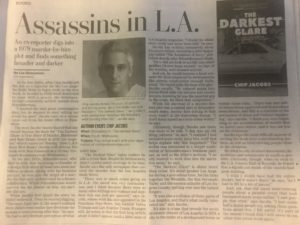 Thousands of newspaper articles later, on subjects ranging from the genesis of the Original Tommy’s hamburger empire to an investigative take-out about a genius environmental businesswoman who ran with shadowy CIA types, I know I stayed in the profession I was supposed to, even if often paid like crap and some of my subjects pined to get me fired. Here’s the thing: every word one writes is one’s own mirror on the world—a reflection of not just dry facts and curated quotes but the writer’s life experiences. My articles were also my Killroy: proof that I was here. They exposed conditions that inspired laws and stoked investigations, painted heroes, identified villains, and, I hope, gave folks blue about their lives a change to laugh. Only this Chip would be weird to write about the joys of personal dumpster diving. All those years remove from USC, I wouldn’t have it any other way! Journalism for me was less an occupation and more a crusade. From my first reading of All the President’s Men, I was hooked. Woodward and Bernstein became my Lennon and McCartney.
Thousands of newspaper articles later, on subjects ranging from the genesis of the Original Tommy’s hamburger empire to an investigative take-out about a genius environmental businesswoman who ran with shadowy CIA types, I know I stayed in the profession I was supposed to, even if often paid like crap and some of my subjects pined to get me fired. Here’s the thing: every word one writes is one’s own mirror on the world—a reflection of not just dry facts and curated quotes but the writer’s life experiences. My articles were also my Killroy: proof that I was here. They exposed conditions that inspired laws and stoked investigations, painted heroes, identified villains, and, I hope, gave folks blue about their lives a change to laugh. Only this Chip would be weird to write about the joys of personal dumpster diving. All those years remove from USC, I wouldn’t have it any other way! Journalism for me was less an occupation and more a crusade. From my first reading of All the President’s Men, I was hooked. Woodward and Bernstein became my Lennon and McCartney.
Transitioning to being an author prone to skipping around in different genres requires many of the same traits: confidence, creativity, a bit of insanity, and a lot of sheer “want-to.” Many assume being an artist is about creating something thought-provoking that you gawk at in art galleries or murmur about on in view of catwalk or book signings. After many years, I view it differently. I believe it’s about challenging oneself to stretch higher than ever imagined, and knowing the result is for both other people’s benefit as well as leaving footprints that our souls recognize as evidence of right-brained free will.
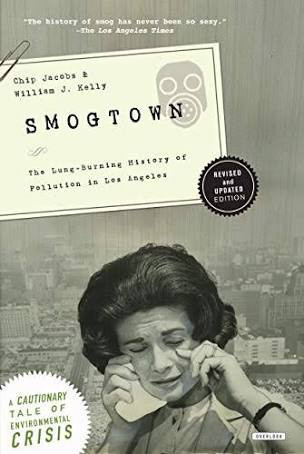
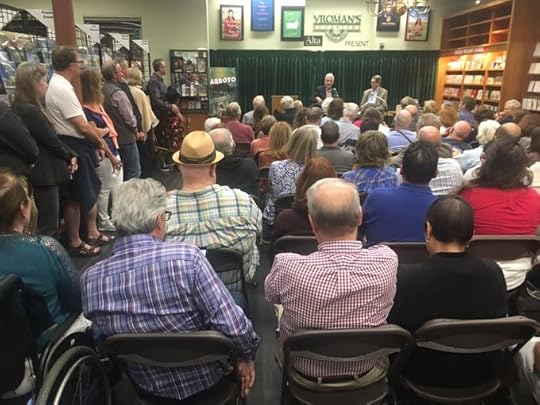
Let’s say your best friend was visiting the area and you wanted to show them the best time ever. Where would you take them? Give us a little itinerary – say it was a week long trip, where would you eat, drink, visit, hang out, etc.
It’s an autumn Friday night, and we’ve been starving ourselves for a gluttonous weekend. Dinner has to be at Park’s (Korean) BBQ, on Vermont Avenue in mid city LA. Come for the grilled meats, stay for the kimchi and pork belly. Did I mention beer was created thousands of years ago specifically for this salty fare?
The following morning is no time for slacking or calorie counting. It’s breakfast at South Pasadena’s retro-roofed Shakers, crispy hash brown, please, and then a drive down the Harbor Freeway to the gray lady — the Los Angeles Memorial Coliseum — to watch my beloved USC Trojans thrash whichever team emerges from the tunnel. Fair warning: I’m as liable to hell at our current coach as any opposing player. Since man doesn’t live on Coliseum dogs alone, it’s Langer’s No. 19 pastrami for a post-game meal. Back home, we fall into the kind of slumbers reserved for pythons after consuming a gazelle.
Sunday, we eat lighter, maybe something from a San Gabriel Valley farmer’s market. Next, my guest allows me to give them a tour of my hometown, just like 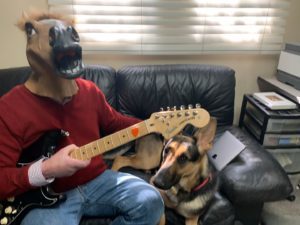 my protagonist Nick Chance in my novel Arroyo. We drive up into the San Gabriel Mountains to see where Thaddeus Lowe’s once world-famous electric railway ran, then walk off some fat by hiking south from the Rose Bowl to where dreamy Busch Gardens and exotic Cawston Ostrich Fam used to sit. Since I can only describe its paintings so well, we venture into the Norton Simon museum for glimpses of the world’s most prize art, from Picasso to you name it . After that, we traipse around Caltech’s shady campus, home of eggheads, Nobel prize winners, and underrated architecture. That night, we’re back on the road, grabbing Ethiopian food (literally with our fingers) at Massob, capped by an intimate show at The Mint LA club. If we’re lucky, we’ll see an enormous talent, like Squeeze’s Glenn Tilbrook, blow the doors off the place. If not, we’ll see a Donovan impersonator (kidding).
my protagonist Nick Chance in my novel Arroyo. We drive up into the San Gabriel Mountains to see where Thaddeus Lowe’s once world-famous electric railway ran, then walk off some fat by hiking south from the Rose Bowl to where dreamy Busch Gardens and exotic Cawston Ostrich Fam used to sit. Since I can only describe its paintings so well, we venture into the Norton Simon museum for glimpses of the world’s most prize art, from Picasso to you name it . After that, we traipse around Caltech’s shady campus, home of eggheads, Nobel prize winners, and underrated architecture. That night, we’re back on the road, grabbing Ethiopian food (literally with our fingers) at Massob, capped by an intimate show at The Mint LA club. If we’re lucky, we’ll see an enormous talent, like Squeeze’s Glenn Tilbrook, blow the doors off the place. If not, we’ll see a Donovan impersonator (kidding).
Come Monday, we get tacos to go from Lupita’s, a strip-mal eatery close to a dog-washing shop, and eat lunch on one of those flyover benches carved inside the historic, Arroyo-Seco-spanning Colorado Street Bridge. The mountain views there are heavenly. Given our fare over the last three days, we might just ascend up those Pearly Gates, grateful to have been alive and hopeful for a return.
The Shoutout series is all about recognizing that our success and where we are in life is at least somewhat thanks to the efforts, support, mentorship, love and encouragement of others. So is there someone that you want to dedicate your shoutout to?
I’d be nowhere, obviously, without the undying belief of my family, friends, work colleagues, plus the tail-wagging support of the mutts I’ve loved. When your dog stares you in the eye, telegraphing a message that he/she knows you can do better than you are, you disregard at your own peril.
High school — in my case, Flintridge Preparatory School just about JPL in La Canada-Flintridge — was where I first discovered my footing for the future. Our history teacher there, John Hamilton, was a brilliant communicator who knew how to breath the past back to life for us bunch of distracted, girl-crazy boys. How? He framed personalities, conflicts, and giant stakes into a narrative that made you hang on his every word. To him, manifest destiny wasn’t only an expression of America’s westward pioneers. It was what lived in each one of us to do whatever it took to extract what we had to offer the world, or die trying. My senior year English teacher, Cheryl Ginzton, was another shaper of me. I still remember vigorously arguing with her about Hamlet’s sanity, and her later urging me to be a writer who followed his curiosity wherever it transported him. Though Mr. Hamilton is no longer with us, my English teacher is. I know that because when I did a book reading at the Pasadena Central Library, she showed up with a copy. Sure, she dozed off while I was reading from my novel, but I was humbled she made it. Plus I will parlay the scene, names changed of course, in a future book fueled by my unquenchable, sometimes pathological need to tell stories.
The contents of this post are nearly identical to the article that ran in Shoutout LA
The post Meet Chip Jacobs: Author, journalist, dog-enthusiast, spiritual optimist appeared first on Chip Jacobs .
May 11, 2021
Trailer for my true-crime book: “The Darkest Glare: A True Story of Murder, Blackmail and Real Estate Greed in 1979 Los Angeles”
It was a sunny place for shady characters back then, with murder-for-hire a cottage industry. The cantankerous zeitgeist is reminiscent of today’s America. Warning: the Kafka-esque events are stranger than fiction.
The post Trailer for my true-crime book: “The Darkest Glare: A True Story of Murder, Blackmail and Real Estate Greed in 1979 Los Angeles” appeared first on Chip Jacobs .
March 29, 2021
1979 L.A. True Crime in Song
It was the faces that slayed you that year, when the only reason for a belly-laugh was a Robin Williams standup act.
The expressions remain amber in memory: the knotted foreheads of Pennsylvanians near the meltdown at the Three-Mile Island nuclear-power plant; Jimmy Carter’s clenched grin realizing circumstance would relegate him to a one-termer. How a January than began hopefully with Terry Bradshaw’s aw-shucks glee after winning a Super Bowl in Miami metastasized in November into rage and disbelief at the righteous scowl of Iran’s Ayatollah Khomeini, who proclaimed “Death to America” as his followers took U.S. embassy workers hostage in Tehran.
For me, an ever-curious seventeen-year-old in the foothills of Pasadena, California, those flickering images, as well as other dismaying ones — the victims of crisscrossing serial killers, dying steel towns, Soviet tanks rolling into Afghanistan — seeded doubts about pretty much everything concerning the future. It was a kind of “Deer Hunter” state of mind.
So, blessed be for those unleashed Les Pauls, for thumping bass riffs, for singers going where the suited adults wouldn’t. The chrome housing of my pride-and-joy Sony stereo rarely grew cold, not as I gorged on a feast of eclectic, envelope-stretching music that painted my world the vivid colors seemingly bled out of the real one. Classic albums, melodic punk, dangerous New Wave: if you needed pretext for an album party, there was always cellophane to unwrap.
Blue-blood acts I adored — Led Zeppelin, Pink Floyd — were proving they weren’t longhaired dinosaurs ducking comets named Deborah Harry, Joe Strummer, Robin Zander or David Byrne. And just as Blue Oyster Cult sang about how nature continually revealed the foolishness of man, 1979 also sped the destruction of the glittery dance ball born from Barry Gibb falsettos, at least as evinced by a crowded, “anti-disco” night in Chicago I wish I could’ve attended.
Why am I effusing about music created when Beyonce wasn’t even born, churned out by musicians with the faint ring of a dive-bar Throwback Thursday trivia contest?
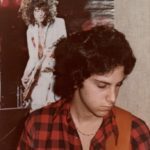 In March of that year, on a rainy evening several freeways away from my bedroom poster of Jimmy Page in his white, dragon pants, a trio of wannabe assassins crouched on the deck of a suburban house in the San Fernando Valley, “America’s Suburb:” The killing in their sights would serve multiple purposes: as trance-inducing revenge for its mastermind, and as the inauguration of his murder-for-profit ring targeting real estate executives who squirreled hefty sums of cash at home.
In March of that year, on a rainy evening several freeways away from my bedroom poster of Jimmy Page in his white, dragon pants, a trio of wannabe assassins crouched on the deck of a suburban house in the San Fernando Valley, “America’s Suburb:” The killing in their sights would serve multiple purposes: as trance-inducing revenge for its mastermind, and as the inauguration of his murder-for-profit ring targeting real estate executives who squirreled hefty sums of cash at home.
Though I wouldn’t piece together this entire, bizarre story until 40-plusyears later, well after I junked my corduroys and mix-tape cassettes, it got me wondering. How would the saga of an only-in-LA business partnership — devolving as it did into treachery, gore, and criminal absurdity — sound if it was told by radio-blared songs rather than the pages of the true-crime book I wrote?
My parameter: do it with through ten works released in ’79, narrowing them to either top-sellers listed by Billboard magazine or ones praised by Rolling Stone and others. My reasoning: music is a sonic reverberation on its times, often depicting the era’s gestalt better us later moored to a keyboard.
***
Once upon a time, there was a young space planner (a.k.a. interior architect) who was brilliant and nerdy. He also wrestled with the labels the city slapped on him, sometimes unsure which way was up. Supertramp’s “The Logical Song” must’ve been his jam.
To compensate for his inexperience, the space planner hired a suave, older associate to be the public face of their upstart firm, Space Matters. This man, from a wealthy West L.A. family that’d yoked high expectations on him, was equally ambitious but also more risk-taking. He sweet-talked his partner into adding hard-hat construction services to their otherwise white-collar enterprise.
“Stagflation” economy” and all, Space Matters killed it at first, landing deals from grand dame Wilshire Boulevard to the futuristic westside. Anyone been to Tom Petty’s “Century City?” They sold to insurance companies and stuffy banks, pop-psychology groups advocating nudity, weed, and primal screaming, as well as a sixties’ counterculture figure turned leasing tycoon. For strange bedfellow colleagues working out of an old mansion near L.A.’s posh “Miracle Mile,” they rolled like they were, in Police vernacular, “Walking on the Moon.”
Voyages, however, are propelled by trust and expertise, not deception camouflaged by toothy smiles. The very partner the young space planner recruited had actually cheated him out of tens of thousands of dollars, jeopardizing everything they’d built. At an ambush meeting at the glitzy Polo Lounge, the blow-dried embezzler was booted out of the promising firm. Let Joe Jackson explain how flimflams are devised. “I’m The Man.”
If this were the old Dick Clark game show, “The $20,000 Pyramid,” the grand-prize question would be why such a talented, charismatic person needed to resort to such knife-in-the-back trickery? The regrettable answer: uncontainable demons, self-shame, and, beneath the surface, paranoia that his wife, a spunky, ravishing woman much his junior, needed to be indulged, lest he lose her. She was, more or less, his “My Sharona,” as presented by The Knack.
The problem with cheaters is that they often cheat multiple suckers, with some less willing than others to answer with a lawsuit or eternal disgust. A monster, who hide behind the legitimacy of his nine-to-five, Joe Sixpack persona, put a contract out on the trickster as proof. When the first assassin he hired to take care of the matter developed cold feet and fled up north, he found himself on the execution list, becoming a “Renegade,” albeit not how Styx imagined.
Even with blinking lights he was being hunted, the older space planner — a man with two daughters, an estranged spouse still open to reconciliation, and many others who loved him — remained in LA when he should’ve booked a flight on the Concord to a remote European village. To squish down his inner torment, he hooked up that stormy night with a former secretary and rolled himself a doobie, felling “Comfortably Numb.” He just could’ve used a wall more fortified than Pink Floyd’s.
The mastermind pounced on his target’s lethargy, driving his El Camino across at least four freeways with his bottom-scraping, gaffe-prone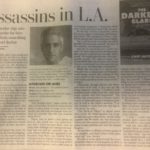 toadies. The intent was bloodier than AC/DC’s “Highway to Hell.” Job done, dozens of Angelenos connected to a bullet-pierced window were petrified of opening their curtain — or seeing that shark-like Chevy round their block. They knew, like Elvis Costello knew, that “Accidents Will Happen.” They just didn’t understand who picked the victims.
toadies. The intent was bloodier than AC/DC’s “Highway to Hell.” Job done, dozens of Angelenos connected to a bullet-pierced window were petrified of opening their curtain — or seeing that shark-like Chevy round their block. They knew, like Elvis Costello knew, that “Accidents Will Happen.” They just didn’t understand who picked the victims.
Nobody had more reasons to keep looking over his shoulder than our nerdy space planner. For months, he “lived” in disguise, under occasional protection of an-ex Israeli mercenary, surviving a botched showdown at the creepy La Brea Tar Pits. It’d take him decades before he could live as blithely as the good timer in Squeeze’s “Cool for Cats.”
And only then with a raging mistrust of the true L.A. behind its sunny mask.
To hear the Spotify playlist from this essay, click here! This essay was first published on Medium here.
The post 1979 L.A. True Crime in Song appeared first on Chip Jacobs .
March 4, 2021
The Man Behind the Gun
Remember the haunting Bad Company song “Shooting Star?” It starts out: “Johnny was a school boy he heard his first Beatles song. Love Me Do, I think it was, and from there it didn’t take him long.”I feature a very different Johnny in my forthcoming true crime book, The Darkest Glare. Johnny Williams was, by most definitions, a mass killer. He also was the assassin in the spectacular, rainy night murder @ the heart of this surreal, darkly funny story. I’m not saying this Johnny was a shooting star, bound for a tragic end after rocketing to six-string fame. I’m saying he wasn’t born evil, from what I’ve gleaned. Much like some football players with CTE, Johnny suffered a traumatic head injury as a kid that seemed to have warped him from a child with an elite IQ and photographic memory into a semi-sociopath blasé about the consequences of his grisly actions. You’ll have to read the book to learn how it happened. Though prosecutors would later conclude that Johnny was brain damaged, it may have been an act, courtroom theater if you will, to help spare him the death penalty. No one ever questioned his criminal ingenuity. Many sure paid for it, though. If only taken up a Stratocaster instead of a M-1 rifle things would’ve been a whole lot different.
The post The Man Behind the Gun appeared first on Chip Jacobs .
March 3, 2021
My true-crime book, “The Darkest Glare,” comes out on March 9. In that spirit, I’m listing — cuz everyone adores lists as much as parfaits and stretchy pants — my favorite works in the genre.
My true-crime book, The Darkest Glare: A True Story of Murder, Blackmail and Real Estate Greed in 1979 Los Angeles, comes out on March 9. In that spirit, I’m listing — cuz everyone adores lists as much as parfaits and stretchy pants — my favorite works in the genre.
In no particular order, they are:
1) The Devil in the White City: Murder, Magic, and Madness at the Fair That Changed America by Erik Larson
2) The Darkest Night: Two Sisters, a Brutal Murder, and the Los of Innocence in a Small Town by Ron Franscell
3) Black Dahlia Avenger: A Genius for Murder: The True Story by Steve Hodel
4) Twentynine Palms: A True Story of Murder, Marines, and the Mojave by Deanne Stillman
5) Shot in the Heart by Mikal Gilmore
6) In Cold Blood by Truman Capote
7) Midnight in the Garden of Good and Evil: A Savannah Story by John Berendt.
To make the cut, a true-crime book can’t just be a surgical recitation of blood, facts, police investigations, and courtroom wrangling. They have to be sharply written and sociological in viewpoints, with unexpected heroics and a sociologists’ eye for cultures that foster good and evil.
The post My true-crime book, “The Darkest Glare,” comes out on March 9. In that spirit, I’m listing — cuz everyone adores lists as much as parfaits and stretchy pants — my favorite works in the genre. appeared first on Chip Jacobs .
February 10, 2021
First Reviews on my True Crime Book, “The Darkest Glare”
REVIEWS …
—(An) engrossingly bizarre tale of a murder plot within Los Aneles real estate circles…An entertaining true-crime period piece built around a chillingly odd sociopathic villain.”—Kirkus Review
—(An) entertaining…true crime narrative…both horrifying and hilarious…Though undoubtedly odd, this (story) still manages to fascinate.” — Publishers Weekly
—”If you’re a fan of true crime and L.A. noir, this one’s for you.”—Southern California News Group
—”If all the praise is to be believed, the author of the L.A. Times bestseller Arroyo— Jacobs’ first crack at historical fiction after producing an impressive array of non-fiction works — has another hit on his hands in the…soon-to-be-released The Darkest Glare.”—Pasadena Now
— “Jacobs’ chops are on brilliant display in The Darkest Glare, a delightfully off-kilter true-crime tale. The prose is intimate, darkly funny, and crisp as he follows. Jacobs’ ear for a good story is pitch perfect.” — Ron Franscell, bestselling author of The Darkest Night
— “In Chip Jacobs true-crime, The Darkest Glare we are whisked back to LA’s Kodachrome world of the Seventies…This is not just another Hollywood Whodunit. In the end we find it is really about one man’s search and struggle to find his own…redemption. Well written and highly recommended.” – Steve Hodel, bestselling author, Black Dahlia Avenger: A Genius for Murder
— “A terrific book – I couldn’t put it down! — Stephen Jay Schwartz, bestselling author of Boulevard
— “Chip Jacobs uses his boundless reporter’s energy and well-honed sense of Southern California to tell a gripping tale…It’s reassuring to see the right writer was paying attention.” – David Willman, Los Angeles Times Pulitzer winning investigative reporter and author of The Mirage Man: Bruce Irvins, the Anthrax Attacks, and America’s Rush to War
On March 10, I’ll be kicking off the book with bestselling true-crime author Ron Franscell on a Vroman’s Bookstore virtual event.
The post First Reviews on my True Crime Book, “The Darkest Glare” appeared first on Chip Jacobs .
October 29, 2020
Yeah, I’ve seen the bridge — the Colorado Street Bridge and a jam session that changed me
Before it meandered into my soul — and, later, my debut novel — Led Zeppelin’s “The Crunge” ranked as one of my least favorite tunes from one of my favorite bands. The little known song, with its heavy bass line and funk guitar, after all, had heady competition on the group’s eclectic “Houses of the Holy” album from 1973. Overshadowing this kinda throwaway number was the rich tapestry of multi-genre rock that would titillate us fans, crackle through speakers. Make us strike Jimmy Page air-guitar poses (absent the dragon pants and violin shredded bow), or lip synch like his bronze-chested front man, Robert Plant. Take your pick of sonic genius: “The Song Remains the Same,” “Over the Hills and Far Away,” “Dancing Davs, No Quarter,” “The Ocean.”
The poor, little “The Crunge” was like a Dickensian orphan, living on the cold English streets on handouts and soupy gruel. Please, sir, can you spare a half pence. The moon children on the album cover stole my money.
My disregard (or dislike) of the song shifted once I got my driver’s license in high school, and my buddies and I searched for safe havens to party beyond the annoying eyes of the Pasadena Police Department. We found our oasis in the accessible, climbable underbelly of the Foothill Freeway’s Pioneer Bridge in a dip into the Arroyo Seco on the west side of town. Just to the south of us? You guessed it. The historic, deadly, and regularly mythologized Colorado Street Bridge. The bridge us local-yokels called “Suicide Bridge” because of the dozens that’d jumped to their deaths from it. Not that any of us knew its origin story.
One day, somebody listening to Zep’s Houses of the Holy picked up on the ending coda in “The Crunge.” Plant, doing a proto-bee-bop, says”
Oh, will ya excuse me
I’m just trying to find the bridge
Has anybody seen the bridge?
Please
Have you seen the bridge?
I ain’t seen the bridge!
Where’s that confounded bridge?
The doggerel eventually coalesced into our mantra, sometimes announced over a portable cassette player (hey, it was the late-seventies) in an off-key chorus of beery, teenage howling. It was as though Zep had written “The Crunge” specifically for our testosterone high-jink and antics in proximity to one of the most famous bridges in America. Decades later, when I was mapping out the reinforcing columns of my novel, I remembered our delirious shouting, “Has anybody seen the bridge?” like a mob of lunatics. It was those memories, if not literary osmosis, that insisted I include it in Arroyo. Not only that, other Zep songs, written in that poetic, JRR Tolkien-flavored, metaphor-heavy style, felt bespoke for my escapist historical fiction. So in allusions to them went with a glint in my eye.
The mystery still remained. Why did Zeppelin include the spoken words, when they rarely did, at the end of this ditty? Thanks to the Google machine, now we know.
According to Song Facts, “The Crunge” was the result of a studio jam session where drummer John Bonham began the backbeat, bassist John Paul Jones jumped in, Jimmy Page got lathered up doing his best James-Brown-guitarist interpretation, and Robert Plant started belting it out. While it’s un-syncopated rhythm renders it virtually impossible for most pedestrIans to dance to, Zep wanted to add steps for it on the album, but it proved to be a logistical stumper. As to the my holy grail question about why there was a reference to a bridge, the answer turned out to be an inspirational bummer. The bee-bop was a reference to “the James Brown song they took the guitar riff from where Brown asks his band to ‘Take it to the bridge.'”
As in the bridge in a traditional pop song separating the verse and the chorus.
Be that as it may, I prefer to believe that somehow, someway, Robert Plant was also winking at the Colorado Street Bridge, Pasadena’s most mysterious, jawbreaking hunk of concrete and steel. That’s why one of Robert’s relatives, as imagined by yours truly, plays an outsize role in Arroyo. Yeah, I found the bridge, and I have Zep to thank for it.
The post Yeah, I’ve seen the bridge — the Colorado Street Bridge and a jam session that changed me appeared first on Chip Jacobs .
September 29, 2020
The Fire That Crackled Inside of Me
The day that lives forever in me began with a pewter-colored mushroom cloud in my rearview mirror. It loomed behind as I was driving to my metro-reporter job at the San Gabriel Valley Tribune on a hot, windblown day in October 1993. At my desk, I checked the newswire, and my stomach tightened. A fast-rampaging brushfire was devouring the foothill neighborhood in east Pasadena where I grew up. Where my elderly parents still lived. In the blink of an eye I was back in my Nissan, this time speeding on the Foothill Freeway’s inside shoulder, headed to my then current-place in Hastings Ranch to figure out what to do. Inside, I discovered my folks had already been evacuated from their mid-century property in Eaton Canyon, and let themselves into my den, with a key I forgot I gave them, to watch TV coverage of the flames, fret about where they’d be sleeping that night, and eat their feelings by plowing through a box of my Triscuits. Soon, my oldest brother, Paul, pulled up. With little discussion, and no zero plan, we decided to drive up to our childhood abode on Kinneloa Mesa to play amateur fireman.
Up in the foothills, the tableau was a wasteland of smoke. You could barely see 10 feet ahead, and every breathe was last gasp inside of a charcoal BBQ. There was repeated coughing and eye-rubbing, and this tacit delusion that we could block Mother Nature’s intentions amid all that dry brush and wooden homes. A white-haired neighbor wandered down to announce, without me asking him, that his place had burned down. Sometimes, “sorry” doesn’t feel very comforting. The fire, set accidentally by an indigent camping in a largely granite ravine, was in the process of destroying one out of every three homes up on the bluff, hopscotching indiscriminately from one roof to the next. Picking survivors and victims, you might say.
When Paul, my parent’s longtime housekeeper, Fong, and I turned the garden hose on to douse embers buzzing about like maniacal insects, only dribbles came out. All the public water, we’d learn, had been tapped. Instead of beating a prudent retreat, Paul and I decided to vamp it. We filled up empty Sparklett’s Water jugs with pool water to extinguish hot spots flaring around the perimeter. He went one way, me the other. I wound up on a neighbor’s land, hacking, unable to see the sun or be sure of my direction, pouring water, with poor efficiency, from an incredibly heavy jug for a liberal arts major. Did I mention I was wearing Topsider shoes with no socks? Not long after, I watched my brother, still in his business attire, nearly fall off the roof, hanging by the rain gutter, during his inspection. It was that sort of day. That sort of predicament where you try batting away little voices of caution by relinquishing to adrenaline. By thinking we’re smarter that the path of destruction.
We decided to take one final recon trip around the house before leaving. For the first time in our bizarre venture into the acrid whiteout, beneath helicopters, bombarded by fire engine sirens, we walked south, behind the Pac-Man-shaped pool, towards a hill abutting another neighbor’s property. There was but one way to turn, right, onto a concrete ledge supporting the pool heater. The three of stopped dead in our tracks there, watching flames gnaw and incinerate weeds and chaparral in the gully below us. It was mesmerizing. It was the precursor flare-up that’d probably burn our entire childhood home down. It was a rubbernecker’s delight. And it was stupendously dangerous. As we stood there slack-jawed, a Santa Ana gust picked up, and when it did, it took mere seconds for the wind to send a curtain of orange, seemingly sun-hot flame ripping uphill at us. I thought we were dead, seeing a little movie of my life – a life starting to bloom with my writing, young wife, and baby on the way. I turned to the side, crouched, and waited to be enveloped. Maybe I could run aflame to throw myself in the pool, God help Paul and Fong.
What would they say at our funerals? One man’s hero is another’s fool.
The concrete ledge, unbelievably, was our fire break. Our unlucky salvation. The scrabbly, gray block is the only reason I’m writing this from planet Earth, rather than remembering it from the Great Beyond. Spared being burned to death, the three of us looked at each other like people who just dodged a meteor or locomotive. We raced back to the car, down the Mesa, and returned to my house with Thank-God-I’m-Alive faces, damp clothes, and a pungent, ashy-sweaty scent. I could’ve used a beer. Or something stronger.
Later that day, Paul and I returned to the old house, stomachs in mouth, as we rounded the corner that would tell us whether the place where we grew up still stood. It was, though the “boathouse” on the lower part of the property was smoldering ruin. The wildfire had immolated the wooden structure like an A-bomb, melting an iron I-beam and hydraulic lift used to hoist a power boat off the floor just to grandstand. Everything in there was gone except the boat, which was parked up in Oregon. Not so fortunate were an assortment of heirlooms, most notably the turn-of-the-century, scuffed organ that my grandfather, Hollywood musician , played during his fruitful show-biz career. The music he made off that simple, portable instrument had given my mother’s family a comfortable life in 1930s Sierra Madre east of Pasadena. The ditties he composed off of it then kept his loved ones off the streets after his picaresque, adrenaline-junkie son broke his neck in a gruesome gymnastic mishap on a rainy day in November 1940. 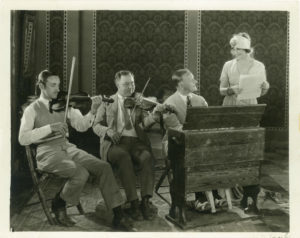
I knew almost zilch about this when I informed my mother that the boathouse was no more. She cried softly, staring with a thousand-yard stare out my kitchen window, barely able to speak.
Curious about the story of that piano, now fascinated by a past whose mysteries called out to me, I quit a prized investigative reporting job at the Los Angeles Daily News in late 1996 to write what became Strange As it Seems: The Impossible Life of Gordon Zahler.” The story would launch my book-writing career, send me to places and onto paths I never could’ve dreamt. And it was all because that mushroom cloud awoke me to ghosts who merited resurrection.
The post The Fire That Crackled Inside of Me appeared first on Chip Jacobs .
May 26, 2020
The Man In The Light
The baseball cracked off the bat, vanishing into the smoggy, gray sky over east Pasadena’s Eugene Field Elementary School. Squinting and craning for it, I became a boy obsessed, a boy determined to make this pop-up fly ball his public conquest. When the spinning white dot finally reappeared, growing in dimension every second, adrenaline was my master.
Only playground dibs needed to be called.
“I got it—I got it!” I hollered that day in 1970, waving my arms like I’d seen Los Angeles Dodgers centerfielder Willie Davis do frequently on TV.
Then again, he was a professional athlete who brandished a mitt. I was an impulsive third grader trying to grandstand for my recess chums by catching a high velocity object with my bare hands.
So, I got it all right—right in the bridge of my nose.
The wicked thump was a horse kick to the face. Seconds elapsed before I realized what’d happened, before I peered down at my T-shirt transmuting from lily-white cotton into an expanding Rorschach of bright red.
My nose wasn’t bleeding. It was an unstoppable faucet. I nearly fainted on the blacktop.
At the school infirmary, the nurse handed me a tissue to staunch the bleeding. Soon, I was in my mom’s pale-blue Ford Mustang, too shaken to guilt her into a therapeutic trip to Baskin Robbins for a double-scoop cone.
“Am I going to die?” I asked her, eyes normally full of mischief clouded with fear. “Do I still have enough blood in my body to live?”
“Don’t be silly,” she replied gently. “You just had a little accident.”
Little?
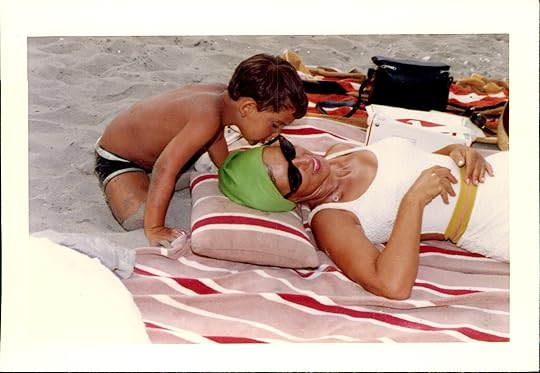 Me probably asking for ice cream a few years before my experience.
Me probably asking for ice cream a few years before my experience.That night, in the lower berth of my cozy bunk bed, I shut my eyes, repeating her guarantee that I’d wake the next morning.
As it were, I wouldn’t sleep through the night.
When “it” happened, I wasn’t facing my turquoise-painted wall, which I normally did to avoid eyeballing the monsters—Dracula, Frankenstein, itinerant werewolves—that I sometimes imagined strolled past my bedroom. I was turned outward.
At roughly 2 a.m., an oval bubble of pristine, white-gold-ish light from the corner of the room summoned me out of a cavernous sleep.
Inside this sparkling incandescence unlike anything plugged into a socket was the bearded, blue-eyed figure that starred in children’s Bible books. The man in the light wore his customary garb—white robe, burgundy sash—and a penetrating expression of bottomless understanding. His sandaled feet levitated above the shag carpeting, which I’d endlessly stained with Welch’s Grape Juice and Elmer’s Glue. He bunched two raised fingers together. Peace.
I lifted myself off the pillow and blinked, certain I was dreaming. Strange. He was still there. I blinked again: He remained. I shook my head in a double-take simulation of cartoon characters shocked to their stenciled gourd.
Yet he remained, aglow for thirty-odd-seconds, with just my Bugs Bunny doll bearing witness. To this day, I remember how the spectacular light haloing him was bright without being blinding, alive and self-generated, its cryatalline particles rotating in place like diamonds.
My pajama top beat to my sledgehammering chest as I galloped into my parent’s darkened bedroom, simultaneously ecstatic and petrified, after He dissolved. Deep down I knew his light was magical.
“Mom, mom!” I stuttered, rocking her still shoulder. “Jesus—he was in my room. Come look.”
Well, she didn’t. She grinned dopily, mumbling, “I believe you.”
After a comfort hug, she fell back to sleep, as if this presence warranted no urgent inquiry. Disappointed, I tiptoed back to my room, imploring my visitor that one trip tonight was enough for this boy.
But questions; yeah, I had a GI Joe lunchbox of them for my mom, an ex-beauty queen turned mercurial social butterfly and unflinching believer. How, I posed the next morning, did Jesus creep into our house? Where did he travel next? Did his robe have pockets? Could telescopes pinpoint his address?
Today, her answers escape me. I do recall her explicitly warning me not to spill a word to anyone, lest they misunderstand, or think I was a liar. Consider his appearance “a gift,” she advised.
“Why did he visit me?” I followed up. Why, after all, was my favorite word.
“You’ll discover that in due time,” she answered.
I must’ve been displeased by her vague explanation, because she volunteered her own ghost story. My jaw plopped open.
Days after her father’s untimely death (this, fourteen years before I was born), she claimed that he’d returned. As in from beyond! She claimed that he roused her from the foot of her bed, engulfed in light, reassuring his heartbroken daughter all was well.
After another round of my rat-a-tat questions, she told me to go play.
Of course, I was an eight-year-old child digesting all this absent any context. I had little inkling then religion was emotional TNT between my mom and Caltech-educated atheist/agnostic father; that they coexisted in a prickly détente in which my two older brothers and I could celebrate Easter and Christmas so long as my mom didn’t flaunt their mystical underpinnings. Even brief mentions of our baptisms ignited closed-door shouting matches everyone could hear.
No wonder my mom taught me the Lord’s Prayer and Memorare at night in hushed tones.
It was my father to whom she hoped I’d never say anything about that night.
Restless curiosity propelled me through college, and then a career as a journalist, where I adored connecting dots and unearthing secrets.
As for my own one, I was circumspect but not silent about the man in the light. Over time, I confided my experience to a handful of people, especially when I believed they could use some inspirational nourishment. Most listened earnestly, courteously—before suggesting that my traumatized brain had conjured a soothing, hologram Jesus. By this logic, evolution was to thank for what I saw in my room, not any creator psychically linked to his creations. Afterwards, I usually regretted saying a damn thing, identifying with folks in the same prickly limbo after encountering UFOs or other supernatural events. We need, for ourselves and our moral latch on the world, to proclaim what happened, and yet to do so risks silent pity at best and outright mockery at worst.
A knee-jerk culture quick to slap scientific denunciations and Twitter memes on any phenomena that fails to reach its vague standards beats you into silence.
Over time, It left me wondering about delusion. Was it me, for recounting the moment that’s lost none of its vividness and beauty over the decades, or doubters who either believe God is a fairytale or a harried divinity with no time for a taxi-door-earred, little kid panicked about how much blood his anatomy could spare?
Lung cancer snatched my cigarette-puffing mom in 2008. My special-needs, middle brother, Peter, followed her unexpectedly in 2012. Their departures isolated me with my oldest brother, Paul, and a cantankerous, ailing father who saw light merely as measurable photons.
By now, I wasn’t the same Chip. I was riveted (okay, fixated) with seeing behind the earthly veil. Near-death experience, past-life memories, reincarnation; you name it I devoured books, articles, videos and whatnot chronicling them. I could dazzle you about the celestial odysseys of the clinically brain-dead, and the child who remembered dying near Japan as a U.S. pilot in World War II. My father, who had been scarred as a Depression-era child, had deemed every bit hogwash.
My zeal about the blurry boundary between life and the afterlife continued to perplex my friends, who wondered if I was squirming with my own mortality—logic that periodically inhabited me, too.
That was before a fateful day in summer 2018.
At a family wedding, I found myself sitting in a pew next to a woman whom I hadn’t seen in years. Maria was the sweet, reserved wife of a handyman-carpenter who’d long worked for my father’s real estate business. Unprompted, she told me of an apparition. (Looking back, people always seems to be doing that.)
On the first anniversary of my father’s passing, at nearly ninety-eight, Maria claimed she’d had a barnburner of a dream. In it, my dad had reappeared before her, looking more vibrant than she’d ever seen him in this plain. The visiting entity asked her to deliver a message. He wanted Maria to speak to Paul, who didn’t share my particular Eastern-influenced Christianity, and was more distraught by our father’s demise than me. Tell him not to anguish, our restored parent said, for he now lived not in an urn at Forest Lawn Cemetery but in a locale electric with spirits.
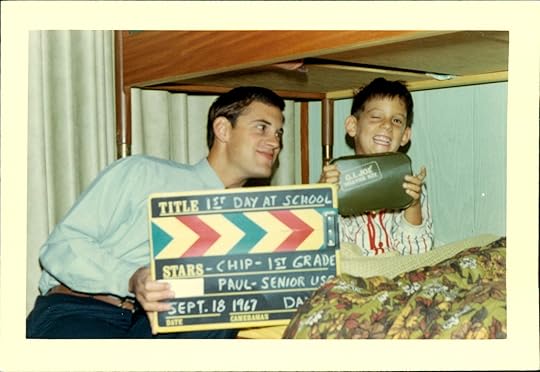 It was in this bunkbed where my celestial gift awakened me.
It was in this bunkbed where my celestial gift awakened me.I asked Maria if her sleep visitor mentioned me. No, she said.
“That’s definitely my dad,” I replied with a teary chuckle. “Definitely.” Paul, still his favorite child, needed that consolation.
Before the day was over, I enjoyed my own awakening: what happened to me in 1970 wasn’t an aberration. Rather, I was an unwitting member of a secret family club in which departed relatives and special guests visited the living in their dreams or, in my case, darkened rooms.
It just so happened then—or was it?—I was writing my first novel, historical fiction swirling around construction of my hometown’s Colorado Street (aka “Suicide) Bridge during the Progressive Age. As a theme, there was no lesson I could impart bigger than exposing death as as nonexistent, that the Grim Reaper isn’t as a collector of souls who takes one to extinction. He’s a corny, cloak-wearing fraud weaponized over the millennia by kings, popes, and profiteers to keep the fearful masses under their thumbs.
I took the plunge, filling Arroyo with a natty guardian angel, a clairvoyant dog, and a main character who must die in abject failure so he can live again to get it right. I did it with the spirit of that cosmic light, because it was hardly just for me.
How selfish, how insecure— how patently cowardly—I’d been until then to allow other people’s blinkered skepticism to keep me from heralding a gift that my mother told wide-eyed me as a child that I’d someday decipher it as an adult. I have.
From now on, the spectral fireworks I felt in my heart, back in my bunk-bed days, will infuse everything I write. My every action. Lord knows I should’ve begun much sooner.
Come on: the trajectory of that nose-smashing baseball wasn’t calculated in error.
The post The Man In The Light appeared first on Chip Jacobs .



